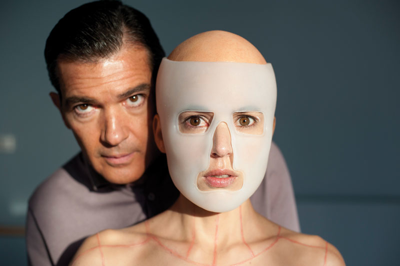In a key scene in The Skin I Live In, Dr. Robert Ledgard (Antonio Banderas) enters his house, and through a monitor resembling a pane of one-way glass, he starts to ogle the body of Vera (Elena Anaya). He's fully clothed, she's nude. He can see her, she can't see him. On the surface, this appears to be a textbook example of male voyeurism and objectification of women — a perv serving as the audience's Peeping Tom surrogate.
Coming from Pedro Almodóvar, however, one of the world's most famous openly gay directors, it's a surprise. And there are more to come, as we find when Dr. Ledgard rushes into the shot. Vera isn't actually naked, she's wearing a body suit — an indication that Dr. Ledgard and Vera's relationship isn't what it initially seems to be. And neither is The Skin I Live In, which combines the kinkiness of Almodóvar's early work with the elegant style of his more recent films before striking off into transgressive new territory.
After his wife's death in a car crash, Dr. Ledgard has been less interested in his plastic-surgery franchise than creating a new skin substitute to replace burned flesh. After 12 years of research, he has created a real product: soft as genuine skin, yet impermeable by either blowtorches or mosquitoes. The only thing Dr. Ledgard needs is a human guinea pig. When his daughter succumbs to tragedy, he finds the perfect subject for his torturous research ... at which point we probably shouldn't say more.
Structurally, The Skin I Live In is one of Almodóvar's most ambitious films. It contains flashbacks from two different characters' perspectives, as well as flashbacks within flashbacks; meanwhile, half the film takes place in the past, with the first and last sections occurring in the present. The first time I saw the movie, I thought Almodóvar had overreached his abilities as a storyteller, indulging his love of melodramatic convolution at the expense of emotional connection to the outré material.
But with repeat viewings, it's apparent that Almodóvar intends something far trickier than a series of lurid gotchas: an experiment in the kind of discomforting audience identification Hitchcock pulled off with characters like Norman Bates. As in earlier films such as Tie Me Up! Tie Me Down! and Talk to Her, he wants viewers to side unwittingly with characters and behavior they'd consider deviant in real life, and toward that end, he's been careful to fill in any potential plot holes. Even a seemingly insignificant detail, like housekeeper Marilia (Marisa Paredes) emptying a pill into a glass of orange juice, comes to seem important.
That doesn't mean all of Almodóvar's provocations work. A subplot involving the doctor's tiger-costumed brother serves only as a plot device with a facile overlay of noxious tawdriness. For the most part, though, The Skin I Live In upends a viewer's expectations and sympathies in purposefully upsetting ways, pulling trapdoors under our certainties about gender and sexuality. With Almodóvar eschewing his typical garish palette for icier hues in camera movements that probe like surgical tools, the film is obsessive and chilly, as are its performances — especially Banderas, whose charisma is used here like a predator's lollipop. You want sympathetic characters? Go see The Help.
Instead, what Almodóvar offers is a purposefully deranged entertainment with a plethora of slyly deployed film allusions. The most obvious reference point is Georges Franju's Eyes Without a Face, whose skin-peeling surgery scenes still carry a grisly charge, but the omnipresence of video monitors recalls another film from roughly the same period, Fritz Lang's The 1,000 Eyes of Dr. Mabuse. But Almodóvar puts a sensual touch even to the cold medium of video — at one point he goes so far as to have Dr. Ledgard lick a monitor. As icy as he often seems, Dr. Ledgard doesn't settle for mere voyeurism. He eventually desires some sort of real relationship with the women he gazes at.
Some observers have called The Skin I Live In phobic — or frivolously indifferent — in its handling of sexual identity. But in this polymorphous shocker Almodóvar has crafted one of his most berserk and bewitching fables about the fluidity of gender and the unpredictability of desire. The Skin I Live In dwells closer to the rangier realms of fan fiction than timid romantic drama. At the start of the film, Dr. Ledgard may be a mad scientist, but he seems like an ordinary heterosexual man. At its end, he may not have departed from his desire to sleep with women — but his director doesn't find him any less queer.
Email arts@nashvillescene.com.





